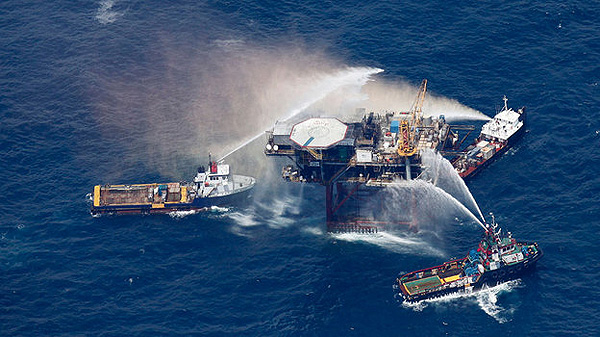
|  |  |  Americas & Beyond Americas & Beyond  
Fire Extinguished On Gulf Oil Platform
 NPR and Wires NPR and Wires
go to original
September 03, 2010


| | Boats spray water on an oil and gas platform that exploded in the Gulf of Mexico, off the coast of Louisiana, on Thursday. (Gerald Herbert/AP) |  |
A fire on an offshore oil platform in the Gulf of Mexico has been extinguished, the owner of the rig said late Thursday.

The platform, about 100 miles south of the Louisiana coast, exploded Thursday morning. All 13 people aboard were rescued from the water in the second such disaster in the Gulf in less than five months.

The owner of the rig, Houston-based Mariner Energy, said the cause of the fire remains unknown and that an investigation is under way.

Louisiana Gov. Bobby Jindal said the company told him the fire began in 100 barrels of light oil condensate, but officials did not know yet what sparked the flames.

The Coast Guard initially reported that an oil sheen a mile long and 100 feet wide had begun to spread from the site of the fire. But officials said at a Thursday afternoon news conference that boats at the platform have not seen any oil sheen.

Seven Coast Guard helicopters, two airplanes and three cutters were dispatched to the site of the Vermilion Oil Platform. It's located about 200 miles west of a site where a BP oil rig exploded in April, spilling millions of gallons of oil into the Gulf of Mexico.

All 13 people aboard the rig were found floating in the water, Chief Petty Officer John Edwards of the Coast Guard said.

"These guys had the presence of mind, used their training to get into those gumby suits before they entered the water. It speaks volumes to safety training and the importance of it, because beyond getting off the rig, there's all the hazards of the water, such as hypothermia and things of that nature," Edwards said.

All were flown to a hospital in Houma, La., to be checked over. Jindal met with some of the survivors. He would not identify them except to say most were from Louisiana.

Dan Shaw, the captain of the boat that made the rescue, said the blast was so sudden that the 13 people didn't have time to get in a lifeboat. He said he found them huddled together, holding hands in the water, where they had been for two hours.

Shaw, 59, said the platform was in flames and there was a lot of smoke, but he did not see any oil in the water. He said the workers did not explain what might have caused the explosion but said there had been painters onboard.

The platform is a fixed petroleum platform that was in production at the time of the fire, according to a Homeland Security operational update obtained by The Associated Press.

The update said the platform was producing about 58,800 gallons of oil and 900,000 cubic feet of gas per day. The platform can store 4,200 gallons of oil.

Jindal said Mariner officials told him there were seven active production wells on the platform, and they were shut down shortly after the fire broke out.

White House press secretary Robert Gibbs said President Obama had been briefed about the explosion.

"We obviously have response assets ready for deployment should we receive reports of pollution in the water," Gibbs said.

Mariner Energy focuses on oil and gas exploration and production in the Gulf of Mexico. In April, Apache Corp., another independent petroleum company, announced plans to buy Mariner in a cash-and-stock deal valued at $3.9 billion, including the assumption of about $1.2 billion of Mariner's debt. That deal is pending.

Apache spokesman Bob Dye said the platform is in shallow water. Responding to any oil spill in shallow water would be much easier than in deep water, where crews depend on remote-operated vehicles to access equipment on the seafloor.

A company report said the well was drilled in the third quarter of 2008.

There are about 3,400 platforms operating in the Gulf, according to the American Petroleum Institute. Together they pump about a third of the America's domestic oil, forming the backbone of the country's petroleum industry.

Platforms are vastly different from oil rigs like the Deepwater Horizon. They are usually brought in after wells are already drilled and sealed.

"A production platform is much more stable," said Andy Radford, an API expert on offshore oil drilling. "On a drilling rig, you're actually drilling the well. You're cutting. You're pumping mud down the hole. You have a lot more activity on a drilling rig."

In contrast, platforms are usually placed atop stable wells where the oil is flowing at a predictable pressure, he said. A majority of platforms in the Gulf do not require crews on board.

Many platforms, especially those in shallower water, stand on legs that are drilled into the sea floor. Like a giant octopus, they spread numerous pipelines across the sea floor and can tap into many wells at once.

Platforms do not have blowout preventers, but they are usually equipped with a series of redundant valves that can shut off oil and gas at different points along the pipeline.

Numerous platforms were damaged during hurricanes Katrina and Rita. The storms broke pipelines and oil spilled into the Gulf. But the platforms successfully kept major spills from happening, Radford said.

"Those safety valves did their job," he said.

With reporting by NPR's Kathy Lohr and Debbie Elliott. Content from The Associated Press was also used in this report.
|

 |
|  |



